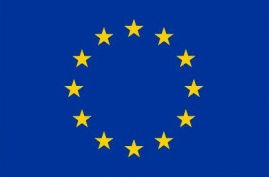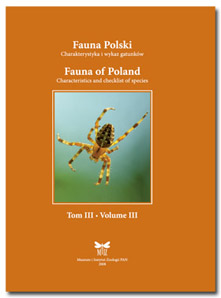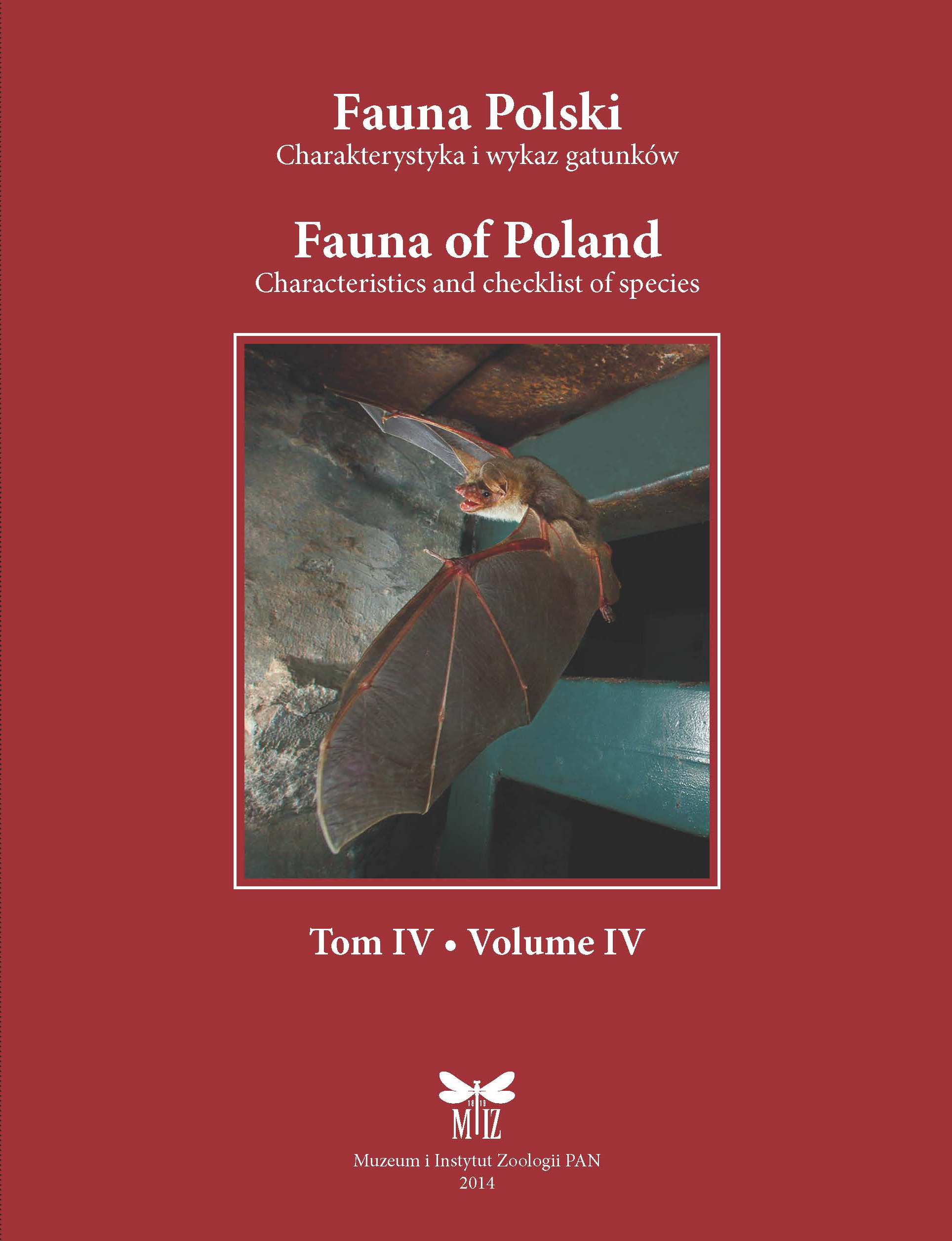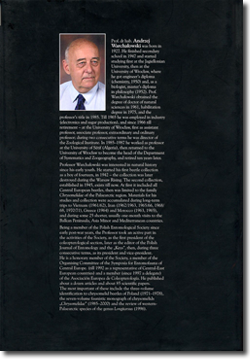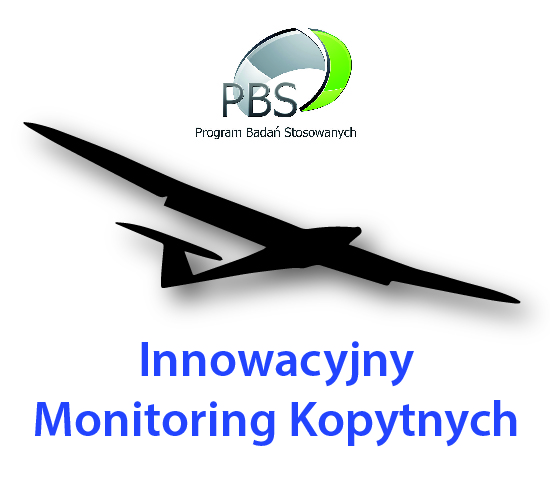Fauna Polski vol. 4 kręgowce - Charakterystyka i wykaz gatunków
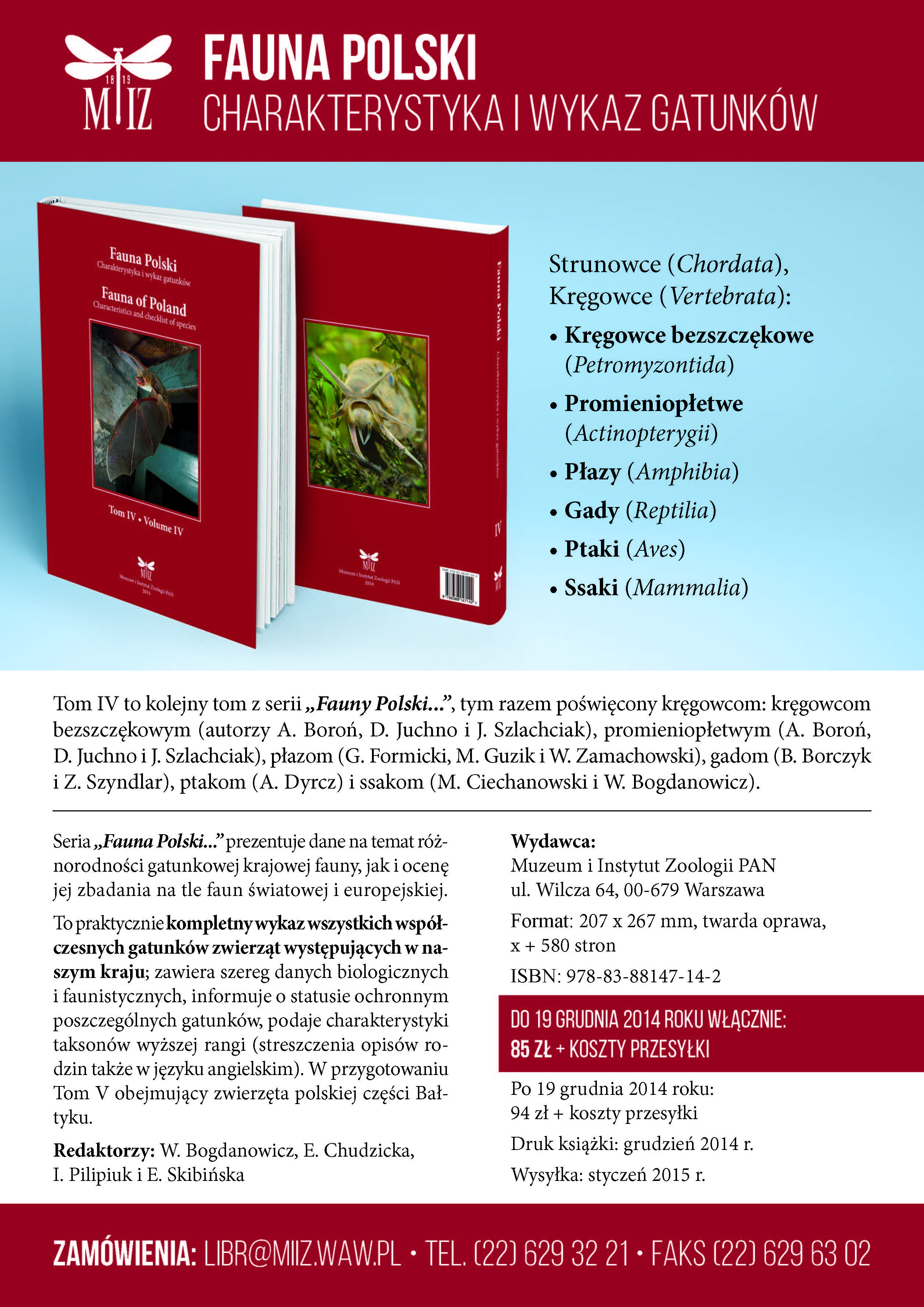
 |
Tom I obejmuje: Annelida, Arthropoda pro parte, Insecta pro parte (Coleoptera, Hemiptera, Hymenoptera, Lepidoptera) Przykładowa strona (tekst) Przykladowa strona z wykazem Edytorzy: Wiesław Bogdanowicz, Elżbieta Chudzicka, Irmina Pilipiuk, Ewa Skibińska. Cena za tom I: 90 PLN + koszty przesyłki Format: 207 x 267 mm, twarda oprawa, 509 str. ISBN: 83-88147-04-8 NAKŁAD WYCZERPANY |
|
|
Tom II obejmuje: Arthropoda pro parte,Insecta pro parte (Coleoptera, Hemiptera, Hymenoptera, Lepidoptera excluduntur) Entognatha Spis treści Edytorzy: Wiesław Bogdanowicz, Elżbieta Chudzicka, Irmina Pilipiuk, Ewa Skibińska. Cena za tom II: 105 PLN + koszty przesyłki Format: 207 x 267 mm, twarda oprawa, xx + 505 str. ISBN: 978-83-881470-7-4 Zamówienia: |
|
|
Tom III obejmuje: Arthropoda pro parte (Chelicerata, Crustacea, Myriapoda) Acantocephala, Bryozoa, Cnidaria, Entoprocta, Gastrotricha, Mollusca, Nematoda, Nematomorpha, Nemertea, Platyhelminthes, Porifera, Rotifera, Tardigrada Edytorzy: Wiesław Bogdanowicz, Elżbieta Chudzicka, Irmina Pilipiuk, Ewa Cena za tom III: 66 PLN + koszty przesyłki Format: 207 x 267 mm, twarda oprawa, xxxii + 603 str. ISBN: 978-83-88147-09-8 Zamówienia: |
|
|
Tom IV obejmuje: Strunowce (Chordata) Kręgowce (Vertebrata):
Redaktorzy: W.Bogdanowicz, E.Chudzicka I. Pilipiuk, E.Skibińska Cena za tom IV: 94 zł + koszty przesyłki (cena po 19 grudnia 2014) Format: 207 x 267 mm, twarda oprawa, x + 580 stron ISBN: 978-83-88147-14-2 Zamówienia: Prosimy o skorzystanie z formularza zamówień lub kontakt z Biblioteką (Sprzedaż wydawnictw) |
„Fauna Polski – charakterystyka i wykaz gatunków” jest opracowaniem monograficznym, którego celem było zgromadzenie kompleksowej informacji o różnorodności gatunkowej naszej fauny, jej walorach oraz stopniu zbadania poszczególnych taksonów. Opracowanie zawiera zestawienie wszystkich współczesnych gatunków zwierząt stwierdzonych w Polsce (zazwyczaj jednak z wyłączeniem fauny Bałtyku) oraz charakterystykę taksonów wyższej rangi, poczynając od typu na rodzinie kończąc. Dla wyróżnionych grup taksonomicznych podano także oceny stanu ich zbadania na tle fauny światowej, Europy, a niekiedy i krajów ościennych. Poszczególne rozdziały zamykają streszczenia w języku angielskim.
Wykazy gatunków występujących w Polsce sporządzone zostały na podstawie danych pochodzących z piśmiennictwa, niepublikowanych danych własnych autorów oraz materiałów muzealnych, które w wielu przypadkach zostały krytycznie zweryfikowane na potrzeby niniejszego opracowania. Wzbogacono je o szereg szczegółowych informacji biologicznych i faunistycznych, dotyczących zarówno miejsca i środowiska występowania gatunku, jego liczebności, preferencji siedliskowych, typu fagizmu i miejsca w strukturze troficznej w biocenozie, jak również taksonomii i ochrony przyrody.
Monografia „Fauna Polski – charakterystyka i wykaz gatunków” ukaże się w czterech tomach (Tomy I, II i III – bezkręgowce, Tom IV – kręgowce), obejmujących grupy systematyczne o różnej randze i wielkości. Jest ona adresowana nie tylko do zoologów różnych specjalności, ale również do przyrodników w szerokim znaczeniu tego słowa. Może być przydatna w pracy konserwatorów przyrody, pracowników parków narodowych i krajobrazowych, służb kwarantannowych, jak i odpowiednich urzędów na wszystkich poziomach administracji rządowej i samorządowej. Powinna ona być także pomocna w nauczaniu biologii w ośrodkach edukacji ekologicznej, w szkołach średnich i na uczelniach.
Coleoptera Poloniae: Tenebrionoidea (Mycetophagidae, Ciidae, Mordellidae, Zopheridae, Meloidae, Pyrochroidae, Salpingidae, Anthicidae)
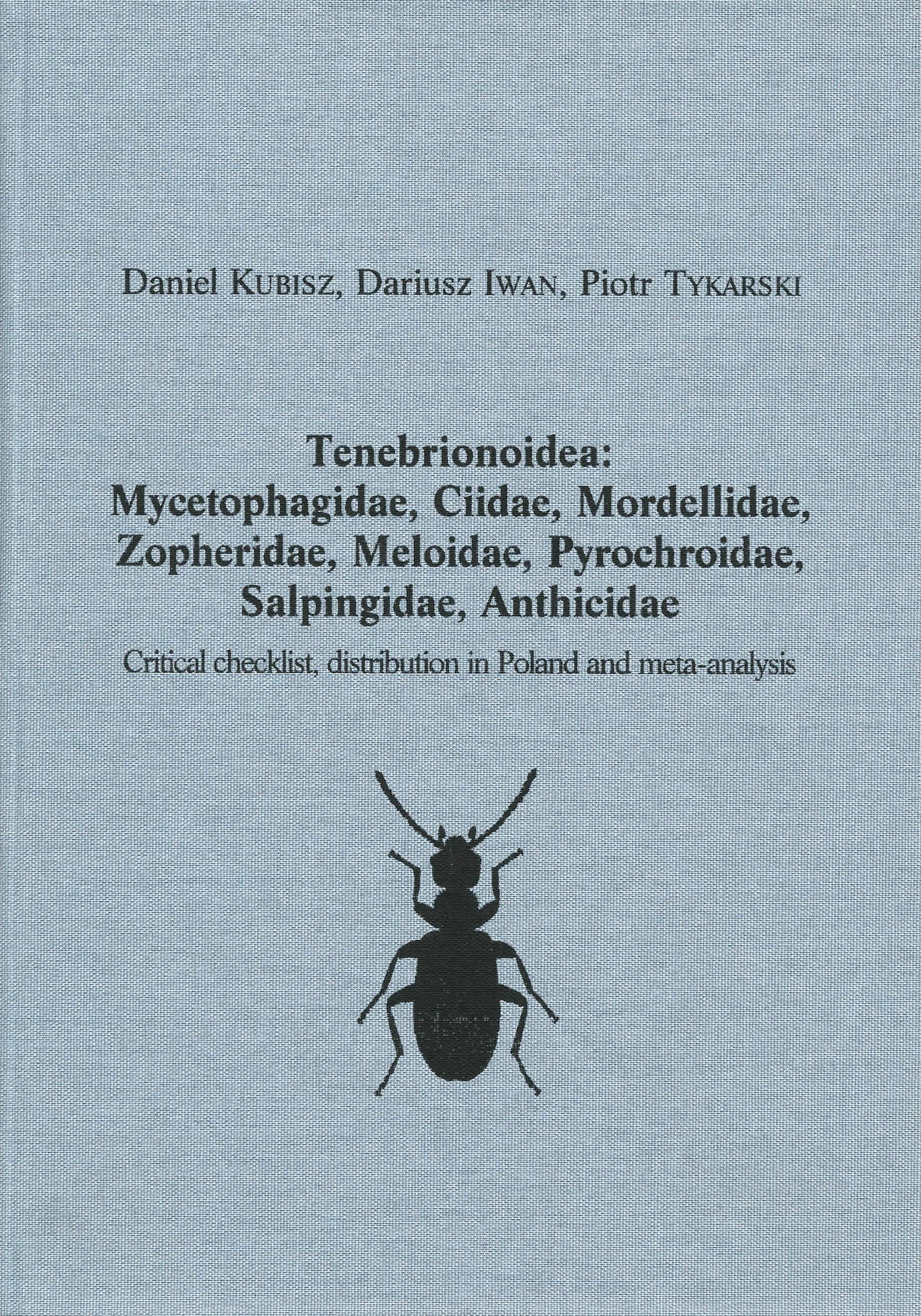 |
Critical checklist, distribution in Poland and meta-analysis Kubisz D., Iwan D., Tykarski P. 2015. Tenebrionoidea: Mycetophagidae, Ciidae, Mordellidae, Zopheridae, Meloidae, Pyrochroidae, Salpingidae, Anthicidae. (Coleoptera Poloniae vol. 3) University of Warsaw – Faculty of Biology, Hardcover, 176 x 250 mm, 744 pages, 403 figures, maps ISBN 978-83-942342-1-8 Price: 35 euro + 5% VAT + postage orders: Please contact Ten adres pocztowy jest chroniony przed spamowaniem. Aby go zobaczyć, konieczne jest włączenie w przeglądarce obsługi JavaScript. |
Please contact our orders department Ten adres pocztowy jest chroniony przed spamowaniem. Aby go zobaczyć, konieczne jest włączenie w przeglądarce obsługi JavaScript., or use online form (secure HTTPS connection)
Special Offer (save up to 70%)
Abstract
The book provides a summary of data on occurrence of Tenebrionidae and Boridae in Poland.
The presence of 73 species of Tenebrionidae and 1 Boridae species is confirmed, while 28
tenebrionid taxa are considered doubtful or needing confirmation, although reported in the past.
Data on distribution of the confirmed taxa cover localities, UTM 10x10 km grid coordinates,
dates, collections that hold specimen, and source references, accompanied by distribution maps
generalized to the UTM grid. A separate chapter gives an overview of Palaearctic distribution of all
the discussed taxa, including subspecies when applicable. Detailed taxonomic checklist of the group
including synonymy is also provided separately. The distribution catalogue part is followed by the
meta-analysis built upon a database covering all the presented information. A number of analytical
and generalization techniques was used, giving synthetic views on research intensity and number of
species known in different parts of the country, commonness-abundance relationship and relative
species richness fives a new quality to traditional faunistics, being paired with the database that will
be available online through the Biodiversity Map and Coleoptera Poloniae websites, served by the
Polish Biodiversity Information Network (KSIB).
Key words
Coleoptera, Tenebrionoidea, Tenebrionidae, Boridae, biodiversity, faunistics, zoogeography,
distribution, meta-analysis, checklist, museum collections, Poland
Fauna Polski - Nowa seria - vol. 5 - The structure and distribution of parasite assemblages of roach (Rutilus rutilus L.)
|
|
Marcin Popiołek The structure and distribution of parasite assemblages of roach (Rutilus rutilus L.)
Museum and Institute of Zoology of the Polish Academy of Sciences Warszawa 2012 175 x 245 mm, 295 pages, twarda okładka, ISBN 978-83-930773-6-6 ISSN 0303-4909 |
Price: 60 euro + 5% VAT + postage
Orders:
Please contact our orders department Ten adres pocztowy jest chroniony przed spamowaniem. Aby go zobaczyć, konieczne jest włączenie w przeglądarce obsługi JavaScript., or use online form (secure HTTPS connection)
Celem badań było wykazanie wielokierunkowego wpływu czynników środowiskowych (naturalnych i antropogennych) na rozmieszczenie oraz strukturę zgrupowań pasożytów płoci (Rutilus rutilus L.) wzdłuż biegu Odry. Analizowane czynniki podzielono na dwie grupy. Do czynników środowiskowych zaliczono: (1) charakter rzeki, (2) poziom uprzemysłowienia terenów przy-ległych, (3) obecność lub brak sztucznych przegród w korycie rzeki, (4) obecność lub brak gospodarstw rybackich, (5) bogactwo ostoi ptaków wodno-błotnych w sąsiedztwie rzeki oraz (5) szybkość nurtu. Wśród czynników fizyko-chemicznych wyróżniono grupy parametrów charakteryzujących: (1) warunki fizyczne i termiczne wody, (2) warunki tlenowe i zanieczyszczenia organiczne, (3) zasolenie, (4) zakwaszenie oraz (5) warunki biogenne. Na siedmiu stanowiskach zlokalizowanych wzdłuż całego, mierzącego 854 km, biegu Odry odłowiono łącznie 451 płoci, które poddano pełnym sekcjom parazytologicznym.
Słowa kluczowe: Pasożyty, Rutilus rutilus, płoć, Odra, zgrupowania pasożytów, czynniki środowiskowe, Polska.
Doryctinae (Hymenoptera: Braconidae) of Japan
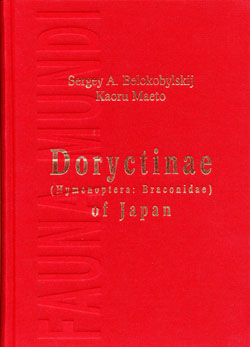 |
Sergey A. Belokobylskij and Kaoru Maeto Publisher: Cena: 180 PLN + koszty przesyłki Zamówienia: |
Streszczenie
A monographic revision of the Japanese taxa of the parasitoids from the subfamily Doryctinae (Hymenoptera, Braconidae) is suggested. A discussion of the morphological features of the adult, biological characters, mode of life and distribution of these parasitoids are presented. A key to 39 genera of the Doryctinae fauna of Japan and neighbouring territories of the mainland Asia is provided. Thirty-one genera and 182 species of doryctins are recorded in the study area, redescribed and illustrated: Arhaconotus Belokobylskij (1 species), Asiaheterospilus Belokobylskij et Konishi (1 species), Caenophanes Foerster (6 species), Cryptontsira Belokobylskij (1 species), Dendrosoter Wesmael (1 species), Doryctes Haliday (10 species), Ecphylus Foerster (5 species), Eodendrus Belokobylskij (1 species), Guaygata Marsh (2 species), Heterospilus Haliday (24 species), Hypodoryctes Kokujev (6 species), Ipodoryctes Granger (2 species), Leluthia Cameron (3 species), Mimipodoryctes Belokobylskij (1 species), Monolexis Foerster (1 species), Neoheterospilus Belokobylskij (1 species), Neurocrassus Snoflak (11 species), Nipponecphylus Belokobylskij et Konishi (1 species), Ontsira Cameron (4 species), Parallorhogas Marsh (5 species), Platy spathius Viereck (1 species), Polystenus Foerster (1 species), Rhaconotus Ruthe (11 species), Rhacontsira Belokobylskij (4 species), Rhoptrocentrus Marshall (1 species), Ryukyu - spathius Belokobylskij (1 species), Sonanus Belokobylskij et Konishi (1 species), Spathiomorpha Tobias (1 species), Spathiostenus Belokobylskij (1 species), Spathius Nees (72 species) and Zombrus Marshall (1 species). The new subgenus Eoheterospilus subgen. nov. (type species Hecabolus rubrocinctus Ashmead) is established for two species of the genus Heterospilus Haliday. Forty-nine species are described here as new for science: Doryctes nipponicus sp. nov., Heterospilus asiaticola sp. nov., H. flavicorpus sp. nov., H. ishigakus sp. nov., H. kerzhneri sp. nov., H. kobeensis sp. nov., H. okinawus sp. nov., H. pumilio sp. nov., H. signatus sp. nov., H. subseparatus sp. nov., H. xanthopterus sp. nov., Ontsira neantica sp. nov., O. amamioshima sp. nov., Rhaconotus brachyceps sp. nov., Rh. sonaicus sp. nov., Rh. watanabei sp. nov., Spathius aichiensis sp. nov., S. alevtinae sp. nov., S. angustifemur sp. nov., S. brevithorax sp. nov., S. elegantulus sp. nov., S. fukushimus sp. nov., S. fuscotibialis sp. nov., S. gnom sp. nov., S. habui sp. nov., S. ibarakius sp. nov., S. insulicola sp. nov., S. interstitialis sp. nov., S. longipetiolus sp. nov., S. longisetosus sp. nov., S. multirugosus sp. nov., S. nagoyaensis sp. nov., S. nakaragawus sp. nov., S. nixoni sp. nov., S. ohboshiensis sp. nov., S. okinawus sp. nov., S. pallescens sp. nov., S. parafasciatus sp. nov., S. paramoenus sp. nov., S. parochus sp. nov., S. rugoscutum sp. nov., S. ryukyuensis sp. nov., S. sagaensis sp. nov., S. similis sp. nov., S. simplex sp. nov., S. solo sp. nov., S. tsukubaensis sp. nov., S. uradanicus sp. nov., S. yonagunicus sp. nov. The following synonymies are suggested: Caenopachys Foerster, 1862 (=Dendrosoter Wesmael, 1838); Heterospilus oculatus Belokobylskij, 1988 (=Hecabolus rubrocinctus Ashmead, 1905); Doryctes strigosus Chen et Shi, 2004 (=D. gyljak Telenga, 1941); Doryctes tristriatus Kieffer, 1921 (=Ischiogonus malayensis Fullaway, 1919); Ontsira retina Chen et Shi, 2004 (= Hypodoryctes fuga Belokobylskij et Chen, 2004); Monolexis sorus Nixon, 1943 (= Monolexis fuscicornis Foerster, 1862); Doryctes nixoni Watanabe, 1952 (= Monolexis palliatus Cameron, 1881); Ontsira brachytes Chen et Shi, 2004 (= O. apposita Belokobylskij, 1998); Rhaconotus carolinensis Watanabe, 1945 (= Rh. formosanus Watanabe, 1934); Spathius leschii Belokobylskij 1998 (= S. lesovik Belokobylskij, 1998). The following new combinations are given: Neurocrassus hakonensis (Ashmead) comb. nov., N. opis (Belokobylskij) comb. nov. and N. palliatus (Cameron) comb. nov. Doryctes yogoi Watanabe was reinstated from synonym of D. mutillator (Thunberg), Ontsira ignea (Ratzeburg) – from O. imperator (Haliday) and Neurocrassus indomalaicus Belokobyl skij – from subspecies of N. rarus (Belokobylskij). The keys to species include the taxa of the Japanese fauna and often also species from the neighbouring territories.
Słowa kluczowe
Parasitoids, Braconidae, Doryctinae, morphological and biological futures, keys to genera and species, redescriptions and descriptions, Japan and neighbouring territories.
Katalog fauny Polski - Nowa seria - vol. 3 - Plant bugs of Poland

Jacek Gorczyca, Andrzej Wolski
Warszawa 2011
Katalog fauny Polski - Nowa seria - vol. 3 - Plant bugs of Poland. Part II. Subfamily Mirinae
ISBN 978-83-930773-3-5 ISSN 1895-5614
Wydawca:
Natura optima dux Foundation
Cena: 63 zł + przesyłka
Zamówienia:
Proszę skontaktować się z działem zamówień lub użyć formularza on-line (bezpieczne połączenie HTTPS)
Abstract
The second part of the catalogue of plant bugs of Poland is presented. It contains 105 species of mirid subfamily Mirinae reported from Poland. All published data are provided, from the oldest WEIGEL’S report to the last faunistic papers. Unpublished data are also included. The current taxonomical status, biology, distribution of species as well as their economic importance are provided. Keys to the tribes and genera of the subfamily are given. The classification system follows the series of the Catalogue of the Heteroptera of the Palaearctic Region.
Keywords
catalogue, faunistics, Heteroptera, Miridae, Mirinae, Poland.
Chrysomelidae
Chrysomelidae. The leaf-beetles of Europe and the Mediterranean area
Andrzej Warchałowski
- One volume in hard cover. The key includes about 1780 species described to the end of 2000 from Europe and the Mediterranean area.
- Illustrated with 504 colour photographs on plates I-LVI and with 3740 black-and-white text figures.
Zamówienia:
Prosimy o skorzystanie z formularza zamówień lub kontakt z Biblioteką (Sprzedaż wydawnictw)
Aby już teraz zapoznać się z nią bliżej zapraszamy do lektury informatora w języku:
angielskim jako pdf
niemieckim jako pdf
francuskim jako pdf
Fauna Mundi - vol. 4 - Ptyctimous mites (Acari: Oribatida) of the Palaearctic Region Systematic part.
 |
Wojciech Niedbała ISBN 978-83-930773-2-8, ISSN 2081-4615 Wydawca:
Prosimy o skorzystanie z formularza zamówień lub kontakt z Biblioteką (Sprzedaż wydawnictw) |
Abstract
On the basis of morphological features a systematic analysis was made of 293 species and two subspecies from the Palaearctic region, belonging to following groups of ptyctimous mites: Protoplophoridae – 15 species, Archoplophoridae – one species, Mesoplophoridae – five species, Apoplophoridae – three species, Euphthiracaroidea – 93 species and two subspecies and Phthiracaroidea – 176 species. For each species a diagnosis was given accompanied by a differentiating analysis between the closest related species.
For five genera and subgenera stat. nov. was proposed, 15 species and five subspecies were treated as syn. nov.; 12 type species and one subspecies were redescribed on the basis of type material.
A chorotype, i.e. geographical range of each species was established.
Keys for identification of cohorts, families, genera, subgenera and species were prepared. As many as 35 species were classified as species inquirendae.
Twenty six species originating from other zoogeographical regions have been introduced to Palaearctic in Prooriental and East-Asiatic parts. The number of wide-distributed species was found to be rather high – 45, including semicosmopolitan, Holarctic and Panpalaearctic ones. Eight species were established to be somewhat less wide-distributed in some parts of the Palaearctic. Over two thirds of the total number of species, that is 215 species were proved to be relatively narrowly distributed and 115 of them were endemic.
Keywords
Acari, Oribatida, Ptyctima, Palaearctic, systematic
Memorabilia Zoologica
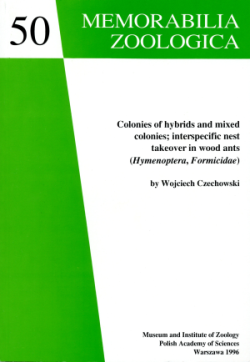 |
Zamówienia: |
|
Tytuł serii
|
Nr serii
|
Rok
|
Autor
|
Tytuł
|
cena zł
|
| Memorabilia Zoologica | 1 | 1958 | Fedorowicz Z. | Ludwik Henryk Bojanus. 47 pp. |
5
|
| Memorabilia Zoologica | 2 | 1959 | Mroczkowski M. | O pierwszej w Polsce próbie monograficznego opracowania krajowych Chrząszczy (Coleoptera). 31pp. |
5
|
| Memorabilia Zoologica | 3 | 1959 | Brzęk G. | Złoty wiek ornitologii polskiej. 175 pp. |
brak
|
| Memorabilia Zoologica | 4 | 1960 | Fedorowicz Z. | Ewolucjonizm na Uniwersytecie Wileńskim przed Darwinem.123 pp. |
8
|
| Memorabilia Zoologica | 5 | 1960 | Kowalska K,. Miklaszewska-Mroczkowska A. | Benedykt Dybowski. Materiały biograficzno-bibliograficzne. Cz.1.99 pp. |
8
|
| Memorabilia Zoologica | 6 | 1961 | Kożuchowski J. | Kijowski okres (1856-1863) w życiu Konstantego Jelskiego.91 pp. |
8
|
| Memorabilia Zoologica | 7 | 1961 | Fedorowicz Z. | Mowa Jerzego Forstera pt.: Limites Historiae naturalis, wygłoszona w Wilnie w roku 1785. 69 pp. |
6
|
| Memorabilia Zoologica | 8 | 1962 | Fedorowicz Z., Kawecki Z. | Maksymilian Siła Nowicki (1826-1890). Na 600-lecie Uniwersytetu Jagiellońskiego. 139 pp. |
10
|
| Memorabilia Zoologica | 9 | 1962 | Fedorowicz Z. | Materiały do historii zoologii na Uniwersytecie Jagiellońskim (1777-1914). 124 pp. |
8
|
| Memorabilia Zoologica | 10 | 1963 | Fedorowicz Z. | Zarys rozwoju fizjografii Polski ze szczególnym uwzględnieniem faunistyki (od czasów najdawniejszych do roku 1918). 185 pp. |
10
|
| Memorabilia Zoologica | 11 | 1963 | Kożuchowski J. | Zarys historii zoologii na ziemiach polskich. 115 pp. |
8
|
| Memorabilia Zoologica | 12 | 1964 | Taczanowski W. | Listy do Antoniego Wagi, Konstantego Branickiego i Benedykta Dybowskiego. 317 pp. |
20
|
| Memorabilia Zoologica | 13 | 1965 | Laszczkowska W. | Zarys rozwoju Biblioteki Instytutu Zoologicznego Polskiej Akademii Nauk. 108 pp. |
8
|
| Memorabilia Zoologica | 14 | 1965 | Bojanus L.H. | De uro nostrate ciusque sceleto commentatio. Rozważania nad żubrem i jego kośćcem. (Krytyczne opracowanie w 140-lecie).186 pp. |
10
|
| Memorabilia Zoologica | 15 | 1966 | Siedlecki M. | Na drodze życia i myśli. Pisma pośmiertne uzupełnione wyciągami z "Notatnika wojennego" Ewy Siedleckiej. 110 pp. |
8
|
| Memorabilia Zoologica | 16 | 1966 | Fedorowicz Z. | Fauna Polski w dziełach o. Gabriela Rzączyńskiego T.J. (1664-1737). 220 pp. |
15
|
| Memorabilia Zoologica | 17 | 1966 | Fedorowicz Z. | Michał Siedlecki (1873-1940). 162 pp. |
10
|
| Memorabilia Zoologica | 18 | 1967 | Kawecki Z. | Władysław Kulczyński (1854-1919). Z posłowiem Stanisława Kulczyńskiego. 112 pp. |
8
|
| Memorabilia Zoologica | 19 | 1968 | Fedorowicz Z. | Zoologia w Gdańsku w stuleciach XVII i XVIII. 121 pp. |
8
|
| Memorabilia Zoologica | 20 | 1969 | Breynius J.Ph. | Prace o czerwcu polskim. De Cocco polonico opera, 1731-1733-1750. 148 pp. |
brak
|
| Memorabilia Zoologica | 21 | 1970 | Fedorowicz Z. | Antoni Wierzejski (1843-1916). 81 pp. |
8
|
| Memorabilia Zoologica | 22 | 1971 | Fedorowicz Z. | Faunistyka w działalności Komisji Fizjograficznej Polskiej Akademii Umiejętności (1865-1939). 184 pp. |
10
|
| Memorabilia Zoologica | 23 | 1972 | Zborowski J., Ferens B., Kowalski | Antoni Kocyan (1836-1916). A przedmową Stanisława Felisiaka. 62 pp. |
8
|
| Memorabilia Zoologica | 24 | 1972 | Fedorowicz Z., Wojtusiak R.J. | Tadeusz Garbowski jako zoolog (1869-1940). 120 pp. |
8
|
| Memorabilia Zoologica | 25 | 1973 | Dylewska M., Kowalska K. i inn. | Oktawiusz Wincenty Bourmeister-Radoszkowski (1820-1895). 121 pp. |
8
|
| Memorabilia Zoologica | 26 | 1974 | Laszczkowska W. | Z dziejów księgozbioru Warszawskiego Gabinetu Zoologicznego (1819-1915). 72 pp. |
brak
|
| Memorabilia Zoologica | 27 | 1975 | Kawecki Z., Wernerówna H. | Opis mapy gdańszczanina Daniela Zwickera (1650) z rozmieszczeniem czerwca polskiego Porphyrophora polonica (L.) (Coccoidea) na Polesiu, uzupełniony dwiema mało znanymi pracami z XVII wieku. 59 pp. |
brak
|
| Memorabilia Zoologica | 28 | 1977 | Kinastowski W. | Próba analizy założeń weismannowskiej teorii dziedziczenia.42 pp. |
5
|
| Memorabilia Zoologica | 29 | 1978 | Social insects in the anthropogenic environments. Proceedings of the 2nd International Symposium held on 17-19th September, 1976 at Warszawa – Jabłonna. 213 pp. |
10
|
|
| Memorabilia Zoologica | 30 | 1979 | Arthropod communities in terrestrial ecosystems. 144 pp. |
10
|
|
| Memorabilia Zoologica | 31 | 1979 | Karczewski J. | Tachinid flies (Diptera, Tachinidae) in the Jędrzejów District.27 pp. |
5
|
| Memorabilia Zoologica | 32 | 1979 | Homeostasis of terrestrial ecosystems. Proceedings of the International Symposium held at Warszawa-Jabłonna, 7-10th June, 1978. 171 pp. |
10
|
|
| Memorabilia Zoologica | 33 | 1980 | Bańkowska R. | Fly communities of the family Syrphidae in natural and anthropogenic habitats of Poland. 93 pp. |
8
|
| Memorabilia Zoologica | 34 | 1981 | Species composition and origin of the fauna of Warsaw. Part 1.258 pp. |
10
|
|
| Memorabilia Zoologica | 35 | 1982 | Species composition and origin of the fauna of Warsaw. Part 2.168 pp. |
10
|
|
| Memorabilia Zoologica | 36 | 1982 | Species composition and origin of the fauna of Warsaw. Part 3.262 pp. |
10
|
|
| Memorabilia Zoologica | 37 | 1982 | General problems of synanthropization. Proceedings of the International Symposium held on 26-31, May, 1980 at Białowieża. 146 pp. |
8
|
|
| Memorabilia Zoologica | 38 | 1982 | Pisarski B. (red.) | Structure et organization des societes de fourmis de l'espece Formica (Coptoformica) exsecta Nyl. (Hymenoptera, Formicidae). 280 pp. |
10
|
| Memorabilia Zoologica | 39 | 1982 | Czechowski W. | Occurrence of carabids (Coleoptera, Carabidae) in the urban greenery of Warsaw according to the land utilization and cultivation. 108 pp. |
8
|
| Memorabilia Zoologica | 40 | 1985 | Present and prognosticated fauna of the housing estate Białołęka Dworska, Warsaw. 166 pp. |
10
|
|
| Memorabilia Zoologica | 41 | 1986 | Structure of the fauna of Warsaw; effects of the urban pressure on animal communities. Part 1. 230 pp. |
10
|
|
| Memorabilia Zoologica | 42 | 1987 | Structure of the fauna of Warsaw; effects of the urban pressure on animal communities. Part 2. 148 pp. |
10
|
|
| Memorabilia Zoologica | 43 | 1989 | Fauna composition and structure of moist meadows on the Mazovian Lowland. 450 pp. |
15
|
|
| Memorabilia Zoologica | 44 | 1990 | Ecology and importance of ants in forest ecosystems. Proceedings of the International Symposium of IUSSI (Łopuszna n. Nowy Targ, 11-16 September, 1989) and other papers. 91 pp. |
8
|
|
| Memorabilia Zoologica | 45 | 1992 | Czechowski W., Pisarski B. | Laboratory methods for rearing ants (Hymenoptera, Formicoidea). 32 pp. |
8
|
| Memorabilia Zoologica | 46 | 1993 | Burakowski B. | Laboratory methods for rearing soil beetles (Coleoptera). 66 pp. | 8 |
| Memorabilia Zoologica | 47 | 1992 | Trojan P. | Analiza struktury fauny. 120 pp. |
8
|
| Memorabilia Zoologica | 48 | 1994 | Ants, fourmis, mrówki... In Memory of Professor Dr. Bohdan Pisarski. (24 papers about ants). 296 pp. |
15
|
|
| Memorabilia Zoologica | 49 | 1994 | Barker G.M. et al. | Proceedings of the II European Meeting of the International Network for Urban Ecology. 288 pp. |
10
|
| Memorabilia Zoologica | 50 | 1996 | Czechowski W. | Colonies of hybrids and mixed colonies; interspecific nest takeover in wood ants (Hymenoptera, Formicidae). 116 pp. |
8
|
| Memorabilia Zoologica | 51 | 1998 | Faunistic Monitoring. 30 pp. |
5
|
Fauna Mundi vol. 3 - Myrmica ants (Hymenoptera : Formicidae) of the Old World
 |
Fauna Mundi vol. 3 - Myrmica ants (Hymenoptera : Formicidae) of the Old World Alexander G. Radchenko and Graham W. Elmes Publisher: Issued: December 2010 |
It is the first taxonomic review of the entire Old World fauna of the widespread temperate ant genus Myrmica that is famed for its interactions with many social parasites of high nature conservation interest, e.g. Large Blue butterflies (Phengaris spp.)
This about 800 pages monograph is more than a traditional taxonomic review, it gives the history of the taxonomic treatment of Myrmica, summarises the current knowledge of the social biology and ecology of the genus, analyses the zoogeography of the various species and outlines the author’s views on the evolution and speciation within the genus.
The authors currently recognise 142 extant and 5 extinct species from the Old World and they provide Identification Keys to the species for each of seven geographic regions. This should make the Keys more user-friendly for non-specialists.
The locations of the type specimens are noted in the taxonomic catalogue, which is arranged alphabetically by species, as are the accurate line-drawings of every species. These illustrate features such as the shape and sculpture of the head and body, used in the identification keys. This arrangement makes it easy to find the data for any particular species.
There is a full list of all names ascribed to genus Myrmica and a table of synonyms from among the valid names is provided. The etymology of many of the names is interesting and provides insights to thoughts of the original authors as does the short biographies are made for all authors of more than one valid species of Myrmica.
The authors believe that there are many species of Myrmica yet to be discovered, particularly in the Indo-Oriental regions and in the southern mountains of Eurasia. This book provides the essential starting point for future studies.
Radchenko is one of Europe’s leading ant taxonomists and an expert on the ant fauna of the Palaearctic, while Elmes is an ecologist and eco-physiologist who has made a particular study of Myrmica ants over a 45 year career.
Prof. Jeremy Thomas (Professor of Ecology, Oxford University) writes:
“This is a much-needed publication. The genus Myrmica ... has been shown to be a key component of all natural and semi-natural (terrestrial) biotopes, and to have many interactions with other invertebrate and plant species that have high conservation value. It is one of the few genera of insects that ‘shapes’ the composition of whole ecosystems.”
“Such is the importance of this ant genus to biology, that scarcely a week that goes by without a paper being published on the socio-biology, behaviour, taxonomy, physiology, ecology, evolutionary biology or interactions of Myrmica: to my knowledge, Nature and Science have published eight papers on these topics since 2000.”
“One of the main problems for conservationists, land managers and non-ant-specialist biologists is that, outside of Western Europe, the taxonomy and identification of the genus is poorly known and keys – where they exist – are very old and not available in English or other widely understood languages ... quite apart from the scholarly yet readable text, the superb illustrations set new standards for ant taxonomists, and are notable for their accuracy and clarity (and beauty). This alone will be of immense help to the many practical biologists who need to work with and to understand Myrmica species.”
Dr. Karsten Schönrogge (Head of Myrmecophily Research, CEH, UK) writes:
"Graham Elmes was a former colleague and I know that he is the foremost expert on the ecology and biology of Myrmica ants, while Alexander Radchenko has an unrivalled grasp of the world-wide taxonomy of this fascinating and important ant genus. Together they have surely produced a unique synthesis of the biology and taxonomy of Myrmica."
Zastosowanie metod molekularnych w badaniach ekologicznych
 |
Cena: 26 PLN + 7 PLN koszt przesyłki Zamówienia: |
Genetyka molekularna znalazła zastosowanie niemal w każdej dziedzinie badań biologicznych, zwiększając tempo zdobywania wiedzy o otaczającym nas świecie. Możliwość szybkiej analizy wybranych fragmentów genomu zaowocowała błyskawicznym wzrostem liczby publikacji poświęconych wykorzystaniu analiz genetycznych w ekologii. Rozwój technik molekularnych stwarza potrzebę usystematyzowania wiedzy niezbędnej do ich stosowania.
Zastosowanie metod molekularnych w badaniach ekologicznych jest próbą odpowiedzi na to zapotrzebowanie. W opracowaniu zaprezentowano podstawowe metody molekularne, wykorzystywane w badaniach ekologicznych oraz przedstawiono zagadnienia, które można badać za ich pomocą. Opisano wszystkie etapy badań, począwszy od sposobu zbierania i przechowywania prób, poprzez izolację DNA, metody badania polimorfizmu genetycznego, po zastosowanie tych metod do rozwiązywania konkretnych problemów ekologicznych (np. do szacowania liczebności populacji, oznaczania płci, oceny tempa migracji). Znaczna część opracowania poświęcona jest zagadnieniom z zakresu genetyki populacyjnej.
Zastosowanie metod molekularnych w badaniach ekologicznych stanowi źródło podstawowej wiedzy w dziedzinie molekularnych badań ekologicznych, będąc jednocześnie punktem wyjścia do poszukiwań bardziej szczegółowej wiedzy. Opracowanie przeznaczone jest zarówno dla osób, które nie miały dotychczas kontaktu z metodami molekularnymi, jak również dla osób posiadających doświadczenie i pragnących poszerzyć swoją wiedzę.
Fauna Mundi vol. 2 - Rhyzobius (Coleoptera: Coccinellidae) a revision of the world species
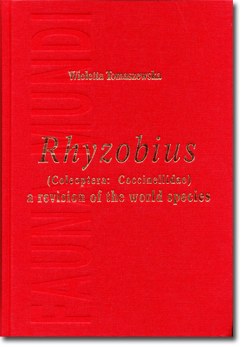 |
Wioletta Tomaszewska Publisher:
|
Abstract
The world species of Rhyzobius Stephens are reviewed and illustrated. The following new synonyms are proposed: Rhyzobius aurantii Blackburn, 1892 (= Rhizobius vulgaris Weise, 1923), Rhyzobius breweri Crotch, 1874 (= Rhizobius corticalis Lea, 1902), Rhyzobius evansii Mulsant, 1850 (= Rhizobius confinis Lea, 1902), Rhyzobius fagus (Broun, 1880) (= Rhizobius satelles Blackburn, 1892; = Rhizobius kingensis Lea, 1908; = Rhizobius erythrogaster Lea, 1929; = Rhyzobius nigrovatus Bielawski, 1973), Rhyzobius nitidus Blackburn, 1889 (= Rhizobius plebeius Blackburn 1892), Rhyzobius pulchellus (Montrouzier, 1861) (= Rhizobius submetallica Crotch 1874; = Rhizobius debilis Blackburn, 1889; = Rhizobius lindi Blackburn, 1889; = Rhizobius coeruleus Blackburn, 1892), Rhyzobius waterhousei (Mulsant, 1850) (= Rhizobius speratus Blackburn, 1889). The lectotypes are designated for: Epilachna pulchella Montrouzier, Rhizobius alphabeticus Lea, Rhizobius apicalis Blackburn, Rhizobius approximatus Blackburn, Rhizobius aurantii Blackburn, Rhizobius bilineatus Weise, Rhizobius brevicornis Weise, Rhizobius breweri Crotch, Rhizobius caecus Blackburn, Rhizobius coeruleus Blackburn, Rhizobius confinis Lea, Rhizobius corticalis Lea, Rhizobius debilis Blackburn, Rhizobius discipennis Blackburn, Rhizobius discoidalis Weise, Rhizobius dorsalis Blackburn, Rhizobius eminens Blackburn, Rhizobius fasciculatus Blackburn, Rhizobius fugax Blackburn, Rhizobius gosfordensis Blackburn, Rhizobius insipidus Blackburn, Rhizobius laeticulus Blackburn, Rhizobius lindi Blackburn, Rhizobius nigrovarius Lea, Rhizobius nitidus Blackburn, Rhizobius nubilus Weise, Rhizobius plebeius Blackburn, Rhizobius pulcher Blackburn, Rhizobius satelles Blackburn, Rhizobius secessus Blackburn, Rhizobius speculifer Blackburn, Rhizobius subhirtellus Lea, Rhizobius umbratus Blackburn, Rhizobius vulgaris Weise, Scymnus discolor Erichson, Scymnus fagus Broun. The following new species are described: R. bielawskii, R. boothi, R. brunneus, R. calderi, R. dryandra, R. gingera, R. gordoni, R. hongae, R. josephi, R. leai, R. lineellus, R. macromaculatus, R. micrus, R. nataliae, R. newtonorum, R. pelion, R. popei, R. pseudopulcher, R. quadrimaculatus, R. reidi, R. rodmani, R. similis, R. slipinskii, R. tasmanicus, R. tribulation, R. unicolor, R. victoriensis, R. wanati and R. weiri from Australia and New Caledonia, R. bipunctatus, R. gonzalezi, R. iracildae, R. jaya, R. leucochaetus, R. luciae, R. metallicus, R. papuensis, R. poorani and R. violaceus from New Guinea, R. indicus, R. riedeli and R. sumatrensis from the Oriental Region. Scymnus fagus Broun, 1880 is here transferred to Rhyzobius (new combination). Nomenclatural history, diagnoses and distribution are provided for each species. Keys to the species of the genus in various zoogeographical regions are presented. Rhyzobius gratus Weise, 1918 is treated here as species incertae sedis due to the unavailability of material for study.
Key words
Entomology, taxonomy, review, Cucujoidea, Coccinellidae, Coccidulini, Rhyzobius
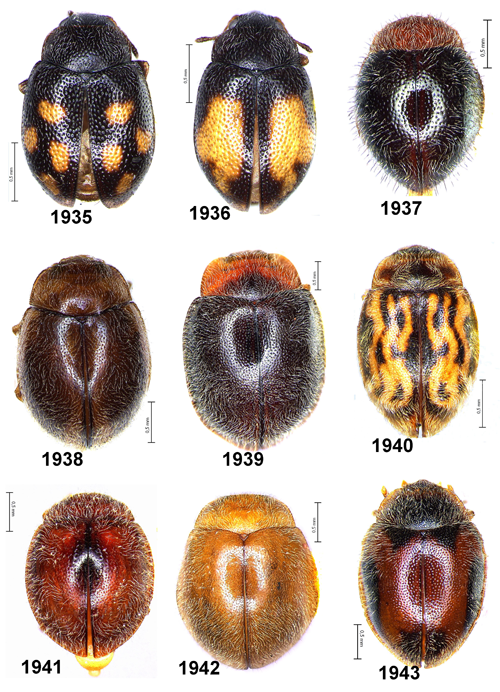
Assemblages of soil Collembola in wetlands in the floodplains of some Polish rivers
MARIA STERZYŃSKA / Museum and Institute of Zoology PAS, 2009

Abstract. Study sites were set up in the valleys of the Biebrza, Narew, Warta and Wisła rivers, whose floodplains differ in morphology, intensity of fluvial and biogenic processes, and degree of natural and human disturbances. The present studied showed that: (1) diversity of Collembola assemblages of river floodplains is maintained by both local and regional processes, (2) low mean population density at the local scale and high global species richness on the regional scale are the main adaptations of Collembola assemblages in river floodplain habitats with natural pulse disturbances, (3) low-dynamic, with natural water regime, marshy floodplains with well developed palustrine zone, shaped by a natural pulse disturbance, maintain a higher global species richness of Collembola and function as a refugee for rare springtail species, (4) the highest discrimination, reflected differences in structure of Collembola assemblages of riverine floodplains, were between type of soils and riverine wetland habitats, (5) Collembola assemblages of riverine floodplains, with accelerating terrestrialization process, can achieve short-duration equilibria and exhibit spatio-temporal seasonal differentiation. The effect of disturbance regime on Collembola assemblages in river floodplains is for the first time quantifed. The diversity pattern, resilience and predicted classification of Collembola assemblages in river floodplains are discussed.
Key words: Collembola, assemblages, diversity, community structure, river floodplains, riverine wetlands, reference area, environmental gradients, local and regional scale, hot spots, disturbance, multivariate analysis
Orders:
Please contact our Ten adres pocztowy jest chroniony przed spamowaniem. Aby go zobaczyć, konieczne jest włączenie w przeglądarce obsługi JavaScript. , or use online form (secure HTTPS connection)
